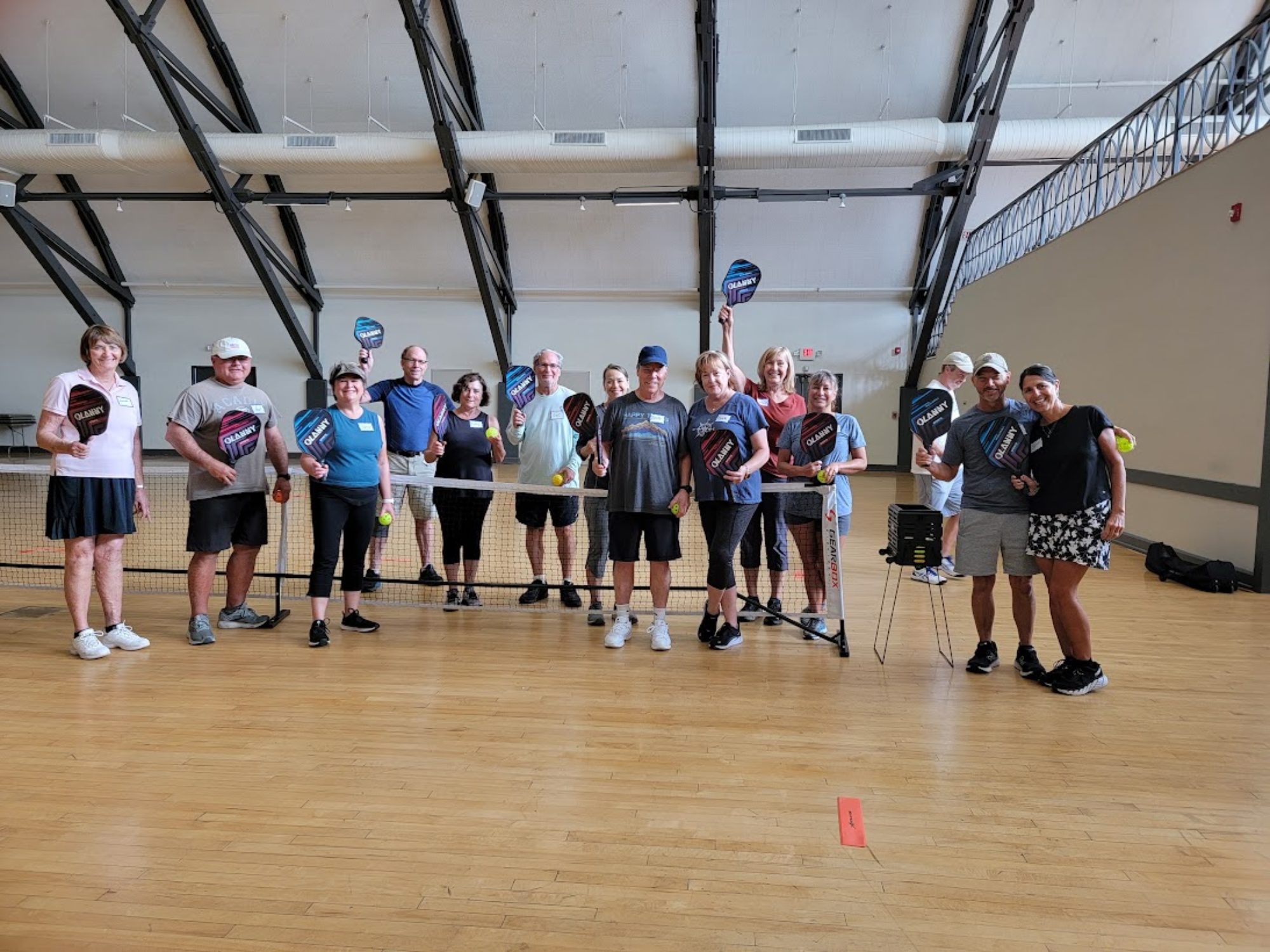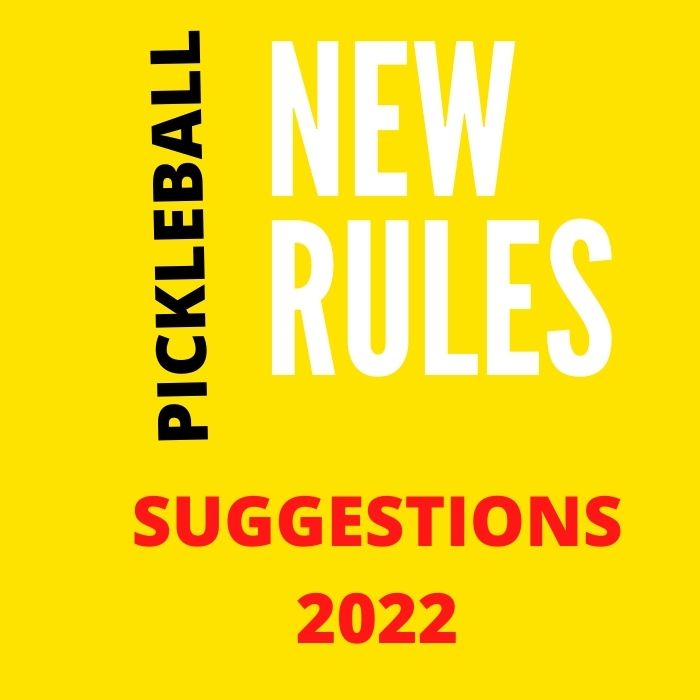The USA Pickleball Rule Committee has recently posted the PROPOSED rule additions/changes for 2022. There are 71 . Some are controversial, and many are clarifications to existing rules.
The ones I feel are most interesting are as follows.
Keep the Drop Serve
The Drop Serve requirement to drop the ball is designed to control the ball from bouncing above the server’s waist so that an underhand/upward arc serve is automatically made. However, the restrictions imposed relating to releasing the ball at a natural height and without additional force have been difficult for referees to judge and to judge consistently. The procedure could be greatly simplified by allowing the server to release the ball in any manner and merely requiring the ball to be hit when it is no higher than the server’s waist, as is done with the traditional serve. Players could then bounce or toss the ball when making a Drop Serve and there would be no need to try to judge whether a player moved his/her hand or jumped a fraction of an inch or imparted force on the ball. Hitting the ball at or below waist level guarantees that the serve is made with an underhand motion/upward arc by most people except those who are really tall.
First serving team gets 2 serves
Doubles. Both players on a team will serve before a side out is declared.
Maintain Serving Order throughout Game
The serving order remains the same throughout each game such that server 1 for each team is the first to serve the ball after each side out followed by server 2 from that team.
Change back to 0 0 Start and discontinuance of drop serve
1 Return the first score to 0 0 Start
2 Discontinue the provisional Drop Serve
No spin on the serve
“At the start of the service motion the ball must be held in the palm of the hand and released either by tossing the ball up from the palm or rotating the hand until the ball is released. If the server is unable to hold the ball in the palm, then the toss of the ball should be done with a minimum of spin applied to the ball.”
Reinstate let serves
4.O Service Lets. There is no limit to the number of lets a server may serve. The serve is a let and will be replayed if:
4.O.1. The serve touches the net, strap, or band and is otherwise good and lands in the service court.
4.O.2. The referee calls a service let.
4.O.3. Any player calls a service let. If the referee determines that a service let called by a player did not occur, a fault will be declared against the offending player.
Rally-point scoring
Doubles. One player on a team will serve before a side out is declared. A side out will occur once a rally is lost or a fault is committed by the serving team and service is awarded to the opposing team.
Since pickleball was originally developed based on a badminton court and some of the badminton rules, you would expect that rally-point scoring would have been implemented in pickleball back when it was implemented for badminton is 2006. (Volleyball implemented rally-point scoring in 1999).
Pickleball remains the only racquet/net sport that has not permanently implemented a rally-point scoring system!
What is rally-point scoring?
- The difference between (traditional) side-out scoring and rally-point scoring is that in rally-point scoring a point is awarded after every rally, regardless of which side served.
- This means that the non-serving side is also able to score points.
- Unlike side-out scoring where the serve goes from server one to server two and then to the opposing team, in rally scoring, it only goes through one server before going to the opposing team.
- As a result, the server number is not called out since there is only one server.
- Server will serve from the side appropriate to their score, i.e. if their score is even the serve will be from the right-hand side, if odd from the left-hand side.
Allow a second serve
4.0 If a player faults on a serve due to a service motion fault, foot fault, or because the ball does not land in the service court, they get a second attempt before the serve is transferred to their partner or opponent(s).
Remove COVID/carry serve
A player deliberately carrying or catching the ball on the paddle while the ball is live/in-play
(From the USA Pickleball website.)
NEW 2022 RULEBOOK REVISION PROCESS
The improved 2022 Rulebook Revision process has begun. We do not expect the 2022 Rulebook to have the extent of change seen in 2021. The window for public input into suggested rulebook revisions is open in accordance with the overall process described below.
What follows is significantly different than last year. Changes were made in response to USA Pickleball member comments and after benchmarking other sport Rulebook processes. We trust that you will see greater transparency, public input and comment opportunities in what follows below. Ambassadors are welcome to share the process below with fellow USA Pickleball members.
Any USA Pickleball member wishing to suggest a modification to the 2022 Rulebook is welcome to submit changes by visiting https://rules.usapickleball.org
Background and Purpose: The process outlined below will be used for the 2022 Rulebook revision. The process addresses the need for improved transparency and greater opportunities for player input and comment. In addition, it formalizes the International Federation of Pickleball (IFP) involvement in rule creation and approval.
The steps below are designed to result in an effective date of January 1, 2022 for the new Rulebook and Change Document.
- Public Input Opportunity. The window for public input for potential Rulebook changes is now open and will end on June 10. Each idea submitted will have a tracking number assigned that will not change throughout the process so interested parties can follow or track a particular idea through the process.
- Public Comment Opportunity. Rulebook submissions will be listed (without attribution) on the USA Pickleball website for public comment. If desired, the IFP President may elect to do the same with the IFP website. The ideas will be posted no later than June 15. This will open up a two-week public comment period.
- Public Review Opportunity. On or before June 30, the USA Pickleball Rules Submission Coordinator will transmit the list of ideas and all public comments collected to the IFP Rules Committee Co-Chairmen. The IFP Rules Committee Co-Chairmen will add any comments collected from the IFP website public comment period. The complete list will be posted on the USA Pickleball website. If desired, the IFP President may elect to do the same with the IFP website.
- The IFP Rules Committee, under the leadership of the IFP Rules Committee Co-Chairmen, and with the advice and counsel of the USA Pickleball Rules Committee Recording Secretary (if needed), will consider each of the ideas on their merits by voting. Each IFP Committee member will vote independently of one another. The vote will be on a 1-10 scale with 10 the highest score, meaning the person voting thinks that idea should be adopted without reservation. There is no relative ranking among the ideas. After voting, the IFP Rules Committee members will have an opportunity to discuss their votes with other members of the IFP Rules Committee in one or more conference calls arranged by the IFP Rules Committee Co-Chairmen. The need for the conference call(s) is at the discretion of the IFP Rules Committee Co-Chairmen. All rule ideas with a combined average score of 5 or more is considered IFP Rules Committee-approved.
- The IFP Rules Committee will complete their deliberations and voting by August 15.
- Transparency of Results. The results of the IFP Rules Committee voting and the status of all Rule ideas submitted to the IFP Rules Committee is planned to be shared on the USA Pickleball website no later than August 20. If desired, the IFP President may elect to do the same with the IFP website.
- The Rules Revision Committee begins writing rules for those ideas with an IFP Rules Committee combined average voting score of 5 or more. Note: Some ideas are submitted already written in ‘rules language’. Those typically don’t require much work. Most submissions, however, require significant attention to get them in the required format and ‘rules language’.
- Each rule idea with a combined average voting score of 5 or more will also be entered into the Change Document. The Change Document will include the reason for each rule change idea. Note: that at this point every rule idea has been subject to either public input and/or comment.
- Transparency of Results. The Rules Revision Committee finishes rule writing and the Change Document by September 15. Once finished, all the written IFP Rules Committee-approved rules (with corresponding tracking number), all the rule change ideas with less than a combined score of 5, and the Change Document are forwarded to the USA Pickleball Rules Committee and posted on the USA Pickleball webpage.
- Transparency of Results. The USA Pickleball Rules Committee meets to vote on each IFP Rules Committee-approved rule. Each rule is voted on separately in the meeting. A rule is approved by a simple majority of the 5 members. The vote is recorded. After the meeting, the voting results will be posted on the USA Pickleball website.
- Transparency of Results. All the written IFP Rules Committee-approved rules (with corresponding tracking number), the rule change ideas with less than a combined score of 5, the Change Document and the results of the USA Pickleball Rules Committee voting are forwarded to the USA Board of Directors for final approval. The USA Pickleball Board of Directors voting results will be posted on the USA Pickleball website.
- Public Comment Opportunity/Transparency of Results. The Rulebook is proofed and published to the USA Pickleball website by December 1. That action starts a 30-day clock where the public can comment on any obvious errors in the draft. This public comment period normally ‘finds’ a small number of errors of omission and it allows players time to get familiar with the changes before the official effective date. The USA Pickleball Rules Committee Chairman can approve changes needed to correct errors that don’t change the intent of the rule. Any changes needed that change the intent of a rule must be approved by the USA Pickleball Rules Committee and Board. The outcome of any such voting will be posted to the USA Pickleball website.
Again, this is just under review and most will not make it into the official rules, so review and let me know what you think by commenting below.
Thanks for reading,

Pickleball Terry
SarasotaPickleball.com
Pickleball lessons and clinics
Dinkpickleball@gmail.com



I strongly feel that if the ball touches the net on a serve and it goes in it should be a let. I do not think it should be played. Obviously if it touches the net but goes out of bounds it is a fault. Stick to the original rules on this one..
Apparently they’re are too many cheaters who constantly call “let” if an ace is served. This levels the playing field for honesty players.
The spin serve should be eliminated. They can solve this in one fell swoop by mandating a drop serve. In table tennis you have to hold the ball in the open palm and cannot impart spin on the ball before serving.
71 rule changes really, is there that much wrong with the game. Stop messing up a perfectly good game with dumb rule changes, and let the game develop and see where it takes us. Now that younger players many of which have high level paddle skill are playing the game has changed and will continue to do so. If that scares some people so be it, go play marbles and leave the game alone.
I WAS GOING TO POST BUT YOU SAID ALL I NEEDED TO SAY. YOU WANT TO KILL A GREAT GROWING SPORT? KEEP RUNNING IT LIKE AN OLD FOLKS HOA. THAT WILL DO IT FOR SURE.
That’s what happens alot to many rules for most games and a few cry babies who can’t adapt.
I STARTED PLAYING PICKLE BALL A YEAR AGO. I PLAYED COMPETITIVE BADMINTON FOR YEARS UNTIL MY BODY DUE TO SO MANY SURGERIES WAS JUST TO BROKE DOWN, AND AGE. LOOKING AT THE PROPOSED RULE CHANGES, I COULD NOT HAVE BEEN HAPPIER WHEN I SAW RALLY SCORING, THAT WAS A HUGE IMPROVEMENT IN BADMINTON. ANY PICKLE PLAYER WHO THINKS RALLY SCORING IS NOT BETTER, HAS NEVER PLAYED IT. I JUST TOOK 3 KIDS 12 AND UNDER OUT TO PLAY PICKLE BALL DOUBLES, WHAT A HEADACHE I SPENT MORE TIME TRYING TO TEACH THEM HOW TO KEEP SCORE, THEN ACTUALLY PLAYING. THE WAY THEY SCORE IN BADMINTON AFTER IT CHANGED TO RALLY SCORING IS SIMPLE, INSTEAD OF PLAYING TO 11 FOR THE WOMEN AND 15 FOR THE MEN, THEY BOTH PLAY TO 21, THE FIRST PLAYER WHO GETS TO 11 POINTS, BOTH PLAYERS THEN WILL GET A 5 MINUTE INTERVAL, TO HYDRATE AND YOU CAN BE COACHED. THE BEST CHANGE IS FOR DOUBLES, ONE SERVE PER SIDE AND IT ROTATES, ALL YOU DO IS CALL OUT THE SCORE, OF COURSE YOU SAY YOUR SCORE FIRST, YOU DON’T HAVE TO WORRY ABOUT WHO IS SCORING. IF THIS GAME IS TO EVER BECOME REALLY BIG INTERNATIONALLY, YOU WILL END UP GOING TO RALLY SCORING, BECAUSE ESPECIALLY THE ASIAN COUNTRIES, WILL BE SURPRISED TO SEE US USING THE OLD BADMINTON SCORING. HAVING PLAYED UNDER BOTH SCORING SYSTEMS, I LOVE RALLY SCORING, IT’S EASIER FOR THE FIRST TIME PLAYERS AND NON PLAYERS TO FOLLOW THE GAME.
I have found the difficulty in teaching someone to keep score is almost entirely related to not understanding why the first serving team only get one serve at the start of a new game. I have found teaching scoring is MUCH faster if you play a dink game with the NVZ acting as the base line. This way you keep the students close and talking about scoring is much easier. Using this method i find i can have the students understanding scoring in half the time.
When using rally scoring the game is over too fast. I play both rally and traditional scoring, and I do not like rally scoring, You can’t compare it to tennis, we don’t play that many games to complete the match. I think, eliminating the 0 0 2 start process is the solution to the problem and it should be deleted from the game. I also would like keeping the “no let serve.” This is not tennis, don’t try to turn it into tennis.
As a longtime volleyball player I hated when we switched to rally score. It became, get it over the net, instead of being aggressive when you’re serving with no penalty. Games will be so quick. I played rally in a tourney and the game took about 5 minutes. Rally is so we can televise games because you have a better idea of the time frame. Oh well, it will happen anyway. So sad. Scoring now is not hard, so that should not be a reason.
👍👍👍
PEOPLE WHO CAN’T FIGURE OUT HOW TO KEEP SCORE OR WHO IS SERVING IN PICKLEBALL ARE MORONS. HOW DID ALL OF YOU PEOPLE SURVIVE THIS LONG PLAYING? ARE YA’ALL JUST SMARTER THAN THE REST?
Fully in agreement as I experienced the same in squash. The score to win a game may need to be increased from 11 to 15 (squash went from 9 to 15, then back to 11) because of rally scoring, but I agree it is much better to move games along faster. I don’t know why there is so much fear of rally scoring when it makes it much easier for all.
I agree with you wholeheartedly about rally scoring since I played competitive indoor Badminton for decades . Like you I choose not to play it due to injury (RC tear) and the natural progression of age.
Repetitive motion and overhead shots are painful despite having reasonably good ROM. Heck I used to be really good at overhead backhand smashes, but bear to even think about it now OUCH!
The rest is to be debated I suppose, but rally scoring is a must for both the sake of the sport and its future. Cheers! 👍
HEY CHRIS EVERTS I HAVE A GOOD IDEA. QUIT PLAYING PICKLEBALL.
Personally, I’m not against rally scoring. I do not see it as that big of a difference as far as playing, (except greatly shortening games), but see the benefits being easier to learn more intuitive scoring for those learning the game. As far as the serve changes, I like seeing the evolution of the game. Offensive serving and spin is part of it, and as it develops and becomes more common, learning to return it will also be more common. I hope the drop serve and the spin toss or chainsaw serves get left in the game. It a skilled shot, and skilled players that play against it often have learned to return it pretty consistently.
It also makes each point mean more. Too many times we see rallies that result in nothing but a back and forth of lost serves. It means that now, I can be rewarded for playing a great point when I am receiving.
Why will the starting team each get 1 serve?
I’m not sure about the ‘holding the ball in the palm of the hand’ before serving. As far as I’m aware no one uses that motion. Most are holding the ball with their fingers pointing downward, below their waste, and basically hitting the ball as they let go of it. A quick review of “how to serve a pickleball” on Youtube proves my point. All the example show the serve holding the ball by the fingers.
It seems to me that having to hold the ball in the palm, as in table tennis, will require virtually everyone to learn a new serve. I understand the need to eliminate adding spin with the hand, bit I don’t think this is the answer.
My understanding of the 2021 rules changes allowing the drop serve actually changed the start of the point to the actual contact with the ball and paddle. So I can’t find any rule about this change, but my big question is this, if the server tries to serve and misses he/she can just pick up the ball and reserve it again right. We have had this happen in our rec play, but were looking for a rule to show everyone. Can you help us out. Thanks.
SO FAR I’VE READ COMPARISONS TO: BADMINTON, SQUASH, VOLLYBALL, TENNIS, AND WHAT ELSE?
HOW ABOUT WE COMPARE IT BOWLING. BOWLING USES A BALL. MAYBE 2 SERVES PER POINT? LIKE 2 BALLS PER FRAME! OR HOW ABOUT BASEBALL? THAT EVEN HAS BALL IN THE NAME. JUST LIKE PICKLEBALL! MAYBE WE COULD DO 3 TRIES PER POINT. KINDA LIKE 3 STRIKES.
OR, MAYBE A BETTER IDEA WOULD BE LIKE LEAVE THE GAME ALONE FOR A YEAR OR TWO.
JUST LET PEOPLE ADJUST TO ONE SET OF RULES FOR A WHILE. YOU’RE WORRIED ABOUT THE “NEW PEOPLE” AND THEIR “IMPAIRED LEARNING ABILITY”. BUT INSTEAD OF WORRYING ABOUT THAT, HOW ABOUT GIVING PEOPLE A CHANCE TO LEARN ONE SET OF RULES FOR A WHILE BEFORE TINKERING WITH THEM AND FORCING THEM (THE LEARNING IMPAIRED) TO RELEARN ANOTHER SET OF RULES EVERY YEAR.
NEVER UNDERESTIMATE PEOPLE’S ABILITY TO SCREW UP A GOOD THING.
There will always be players who value the score more than the game play. For these players serve aces are paramount. I am 74 years old. I play seven days a week, sometimes twice a day in rec play. I experimented with a chain saw serve and a spin drop serve. If I am starting the game, I could run up 8 or 9 points on non returnable serves. This is not fun for me nor my opponents.
I no longer try to ace a serve. I will serve hard and deep and vary my speed but these serves are returnable with skill development. No amount of skill will allow someone my age to consistently return a severe spin serve.
The game has grown because it is fun and fairly easy to play. “trick” serves eliminate both.
In my club there are several young players (under 40) who have won gold and silver in regional tournaments. I love playing against them because I can rely on tactics rather than physical ability to be somewhat competitive. The best game I ever participated in was against two young gold winners in doubles. My side lost 11-0. Yet it was a great game with every point contested and fought for. Thanks for ibuprofen. I hurt for days- a good hurt and they learned some good strategy.